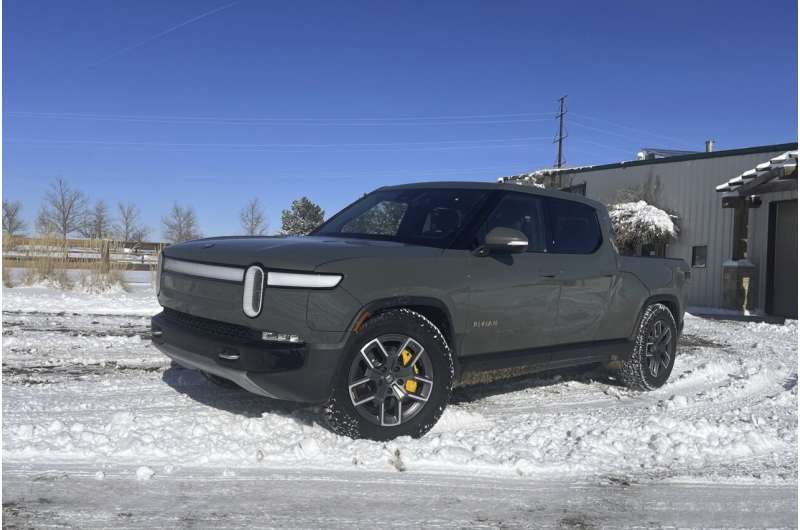This article has been reviewed according to Science X's editorial process and policies. Editors have highlighted the following attributes while ensuring the content's credibility:
fact-checked
reputable news agency
proofread
What you actually need to know about wintertime driving with an electric vehicle

As a big winter storm rolled across the United States in mid-January, many news outlets reported on drivers of electric vehicles dealing with dramatically reduced range and multi-hour waits at public charging stations. It's true that driving an EV in freezing weather poses extra challenges compared to a gasoline-powered vehicle. But it's also possible to employ techniques that can make EV winter driving less challenging. The car experts at Edmunds report on what you can do.
WHY EVS SUFFER IN WINTER DRIVING
Freezing temperatures slow down chemical reactions in batteries. You've likely experienced this with a regular car when its 12-volt battery struggled to start the engine. It's the same with an EV. Their batteries work best in warmer temperatures, and the vehicle will actually use some stored energy to warm up its battery if it's cold. An EV also needs to use its battery to run the cabin heater, heated seats and so forth. All of these issues can combine to noticeably reduce range.
How bad can it get? Expect a range reduction of 20% to 30% in very cold weather. That means an EV with a usual maximum range of about 250 miles might only have 175 miles in freezing temperatures, for example. Cold batteries also charge slower at fast-charging stations.
CHARGE AT HOME AS MUCH AS YOU CAN
If possible, keep the battery topped up by charging at home every day. While most automakers recommend keeping your EV charged to 80% for typical driving to enhance battery longevity, consider charging to 100% in winter conditions to give you the most range possible to help offset reduced range. By charging at home, you can avoid public fast-charging stations that might be crowded or not functioning optimally.
WHEN TO USE PUBLIC FAST-CHARGING STATIONS
EVs don't charge as quickly at high-powered charging stations in very cold weather, which can lead to delays. If you can't charge at home or at work, try using public charging stations during the least busy hours such as early in the morning or late at night to better avoid any long lines. Also make sure that your EV is set to precondition the battery before charging at a fast-charging station. In cold temperatures, EVs can heat their battery up to the optimal temperature needed for fast charging. This preconditioning uses some of the battery's power but will improve charging speeds.
KEEP YOUR EV'S BATTERY TOPPED UP
Charging frequently can help you be prepared in case of power outages or unforeseen traffic delays. For example, consider charging every day at home even if you don't really need to. For the reasons noted above, it might be harder to charge at a public location if you need to. But you can still look for convenient opportunities to charge when it's not a necessity. Just make sure you're not holding up other EV drivers who also might need to charge.
PREHEAT THE CABIN AND BATTERY
One of the best tips for wintertime EV driving is to preheat the cabin before you drive. Not only does that make the car warm for you, preheating also warms the battery before you drive. It's best to preheat your EV while it's charging at home because it won't drain the battery's charge. Most EVs can preheat via an integrated smartphone app.
DRIVE EFFICIENTLY
With shorter range in winter driving, it's important to drive as efficiently as possible by using the Eco drive mode if your EV has one. It increases its efficiency by limiting its power. If you don't have an Eco mode, then one of the best ways to drive efficiently is by not accelerating quickly. If your battery is low, consider using the heated seats and heated steering wheel if you have them instead of the heater, which uses a lot of the battery's energy.
CONSIDER GETTING EV WINTER TIRES
Just as with gas-powered vehicles, swapping out an electric vehicle's all-season tires for winter tires can significantly improve traction and braking performance on snowy or slippery roads. Many tire manufacturers make winter tires specifically for EVs. It's also important to keep the tires inflated to the manufacturer's recommended level to get the best efficiency and winter weather performance.
EDMUNDS SAYS
Incorporating the above tips will make wintertime driving in an EV easier. But also check your vehicle's owner's manual for additional tips and recommendations for wintertime driving.
© 2024 The Associated Press. All rights reserved. This material may not be published, broadcast, rewritten or redistributed without permission.



















